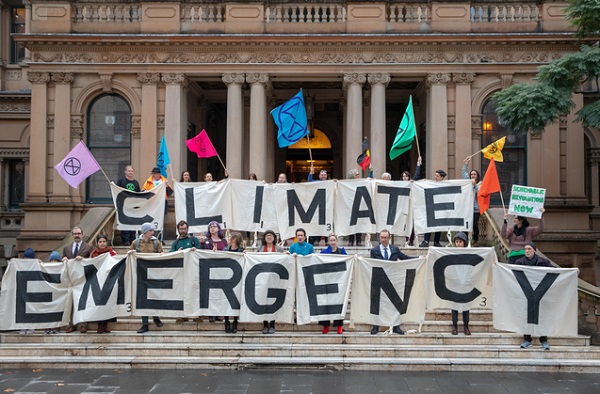
Time to declare a climate emergency is now. Arguably we should have done so when James Hansen addressed the US senate in 1988. Twenty years later he was judged to have got it right.
This post started as life a new Climate clippings, so it follows that format. It looks at scientific reticence in relation to mainstream climate science, how the real urgency of the climate situation is moving to the centre from the periphery in climate science, and where we find ourselves now especially in relation to emissions, temperature and sea level rise.
1. The climate change election did not happen
The last Climate clippings was before the election. Of particular relevance was Item 3 on the SMH story Pro-coal Nationals hold electorates most at risk from climate change. They included Barnaby Joyce (New England), Andrew Gee (Calare), Ken O’Dowd (Flynn), Michelle Landry (Capricornia) and Llew O’Brien (Wide Bay).
Leaving Queensland’s 30 seats aside, the election, was won by Labor with 62 of the remaining 121 seats, the LNP won 54, the Greens and others 5. So effectively the election was decided in Queensland, where the LNP won 23 seats, Labor only 6, and Katter one. There were various reasons for Labor’s defeat, but climate change was not one of them. Rather, voters were presented with the virtues or otherwise of developing one coal mine.
However, many voters were concentrating on their best chance of earning decent money during the next decade or two. The question as to whether this may be this at the expense of any kind of life at all for their grandchildren, plus generations to come after that, was not seriously put to them.
Scientists are now increasingly talking about the climate emergency as an existential threat, meaning that human life in its present form would be in play. We need to take them seriously unless we can show 100 per cent that they are wrong. Which, of course, we can’t.
2. New study shows IPCC is underselling climate change
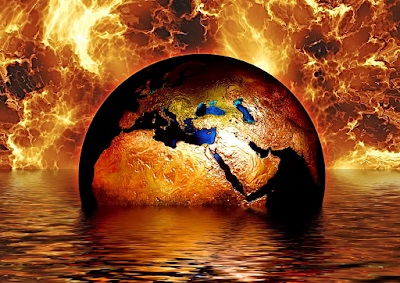
- A new study has revealed that the language used by the global climate change watchdog, the Intergovernmental Panel on Climate Change (IPCC), is overly conservative – and therefore the threats are much greater than the Panel’s reports suggest.
And:
- “We found that the main message from the reports—that our society is in climate emergency—is lost by overstatement of uncertainty and gets confused among the gigabytes of information,” says lead author Dr. Salvador Herrando-Pérez, from the University of Adelaide’s Environment Institute and Australian Centre for Ancient DNA.
Plus:
“The accumulation of uncertainty across all elements of the climate-change complexity means that the IPCC tends to be conservative,” says co-author Professor Corey Bradshaw, Matthew Flinders Fellow in Global Ecology at Flinders University. “The certainty is in reality much higher than even the IPCC implies, and the threats are much worse.”
Those are quotes from the Climate Code Red post, linked above, from the study by Salvador Herrando-Pérez et al. Statistical Language Backs Conservatism in Climate-Change Assessments, BioScience (2019). DOI: 10.1093/biosci/biz004.
3. What lies beneath
James Hansen has been complaining about scientific reticence for what seems like forever. There is now a body of literature supporting his claims. For example, see David Spratt and Ian Dunlop in What Lies Beneath: The scientific understatement of climate risks:
- we now have evidence that significant tipping points –– for example, summer sea-ice free Arctic conditions, the loss of West Antarctic glaciers and a multi-metre sea-level rise –– have very likely been passed at less than 1°C of warming.
And:
- Warming of 1.5°C would set sea-level rises in train sufficient to challenge significant components of human civilisation, besides reducing the world’s coral ecosystems to remnant structures.
Plus:
- Orwell could have been writing about climate change and policymaking. International agreements talk of limiting global warming to 1.5–2°C, but in reality they set the world on a path of 3–5°C.
The foreword of the report was written by one of the most eminent climate scientists on the planet, Hans Joachim Schellnhuber, who is a professor emeritus of theoretical physics specialising in complex systems and nonlinearity, and founding director of the Potsdam Institute for Climate Impact Research (1992-2018). He says:
- In conclusion, one should not be overly critical of the IPCC, since the scientists involved are doing what scientists are expected to do, to the very best of their ability in difficult circumstances.
But climate change is now reaching the end-game, where very soon humanity must choose between taking unprecedented action, or accepting that it has been left too late and bear the consequences.
Therefore, it is all the more important to listen to non-mainstream voices who do understand the issues and are less hesitant to cry wolf. Unfortunately for us, the wolf may already be in the house. (Emphasis added)
4. A near-term scenario
Spratt and Dunlop have followed their earlier work with another report – Existential climate and security risks: a scenario approach. After again addressing the problem of scientific reticence, they outline a 2050 scenario. This will give you some idea:
- While sea levels have risen 0.5 metres by 2050, the increase may be 2–3 metres by 2100, and it is understood from historical analogues that seas may eventually rise by more than 25 metres. Thirty-five per cent of the global land area, and 55 per cent of the global population, are subject to more than 20 days a year of lethal heat conditions, beyond the threshold of human survivability.
Schellnhuber says climate science is being transformed from the periphery. There is no doubt that the world is watching what Spratt and Dunlop are saying with coverage from the Guardian, Independent, New Scientist and Al-Jazeera to CNN, CNS and ABC in the USA, amongst others, prompting an article Stirbt die Menschheit aus? by Christian Mihatsch, published in translation as Is humanity dying? It contains this graph:
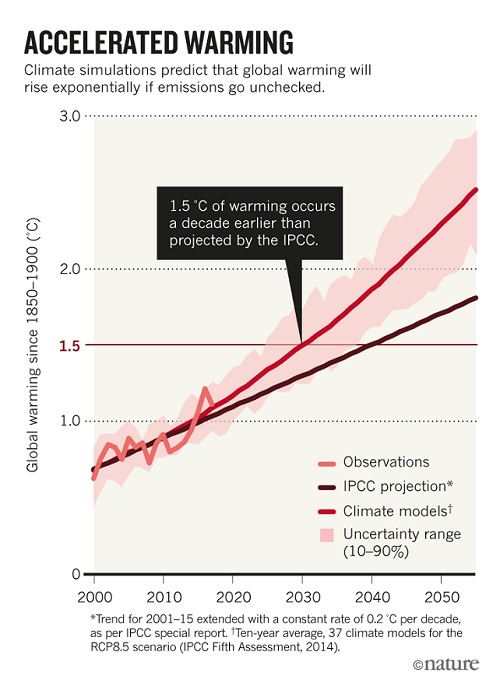
That is what is now forecast using climate models to project from the modern instrumental record. The problem is, as James Hansen says in Climate Change in a Nutshell: The Gathering Storm, that if you want to calculate the long-term implications, you have to go beyond climate models, which he fully understands, to paleoclimate information. Very few scientists do.
5. The problem lies in specialisation, perspective, understanding of climate sensitivity, and risk
Few people understand, I think, that the two degrees target (history here) was formulated by a 1990 team of researchers from the Stockholm Environment Institute (SEI) who attempted to define what constituted dangerous climate change. In 1975 William Nordhaus a Yale economics professor had suggested that warming of more than two degrees would push the climate beyond the limits humans were familiar with. The SEI scientists suggested that to avoid the worst impacts of climate change, a limit should be set at two degrees. However they warned:
“Temperature increases beyond 1.0°C may elicit rapid, unpredictable, and non-linear responses that could lead to extensive ecosystem damage,” the report said, suggesting there is nothing necessarily ‘safe’ about a two degree limit. (Emphasis added)
Two degrees became a guardrail, safe on one side and dangerous on the other in the public mind after it was accepted first by the Europeans, and then by almost all nations in the world in the UNFCCC in Chile in 2010. All, that is except Bolivia, who held out but was ignored by chair Christiana Figueres, who simply brought down the gavel. Strictly she should not have, because UNFCCC require consensus, which is perhaps why the UNFCCC targets are as they are. Countries like Russia, Saudi Arabia, not to mention the US while they are there, and Australia have to agree.
The one degree limit had been sought by a group of developing countries including low-lying island states, who were subsequently given the ‘we’ll do 1.5°C if we can’ concession at the Paris conference in 2015. Five years ago Malte Meinshausen formulated graph I found in The Climate Authority Review of targets:
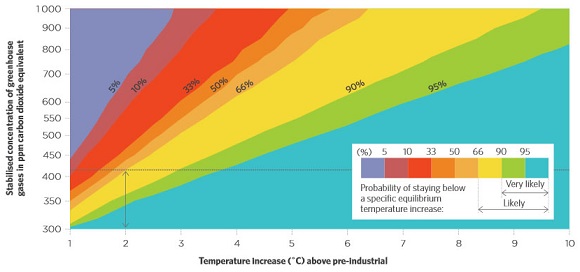
The straight lines pinpoint about 425 ppm as associated with a 66% chance of staying within 2°C. Those are the ridiculous odds that have become normalised in thinking about climate change.
Please note, the graph effectively starts with the Eemian, which, with 300 pmm, already had 6-9 metres of sea level rise.
Scientists like James Hansen and some others were never happy, but in fact the IPCCC process marginalised them.
Scientists working with models based on the instrumental record could only take into account short-term ‘Charney’ feedbacks of about 50-60 years. I deal with this issue here. Longer term feedbacks, which Hansen says are coming into play now could double value of climate sensitivity, ie. the warming caused by doubling CO2.
6. Longer term implications
Hansen has done a lot of work on the big questions over the last 10-15 years. Typically he co-opts multiple authors, I recall 41 in one piece, including scientists from a variety of climate specialties in a number of institutions, so there is built-in peer review. Then he publishes a draft for everyone to comment, followed by a final text taking into account the comments made.
In Nutshell it’s just Hansen, but on his site he shows it as an 18 December 2018 draft. It is based on much of the work he has done over recent years. On page 13 he says:
- the eventual warming for 407 ppm CO2 will be about 3.5°C, including the full effect of both fast and slow climate feedback processes.
On sea level rise he says on page 26:
- sea level reached heights as great as 6-9 meters during the prior interglacial period, the Eemian about 120,000 years ago, when global temperature was only about 1°C above the pre-industrial level, i.e., similar to today’s global temperature. During the early Pliocene, several million years ago, when global temperature was at most about 3°C warmer than pre-industrial conditions, sea level probably reached as high as 15-25 meters above today’s level.
The largest factor in sea level rise so far has been thermal expansion. Hansen says this will be swamped by ice sheet decay, which will cause a repeated doubling of sea level rise within a relatively short time frame. On page 30 he says:
- doubling time for ice sheet mass loss, assuming continued growth of fossil fuel emissions, may be as short as 10-20 years, based on evidence from the combination of paleoclimate data, modern observations, and ocean-atmosphere modeling. In that case, multi-meter sea level rise would occur on a time scale of 50-150 years.
He gives this helpful map with the blue and yellow parts showing what 75 metres (complete deglaciation) does to some parts of the world:
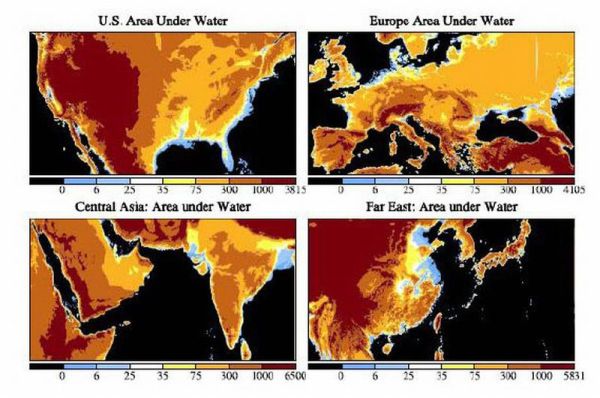
His maps don’t extend to us, but Spratt has helpfully provided a map of what complete deglaciation will look like:
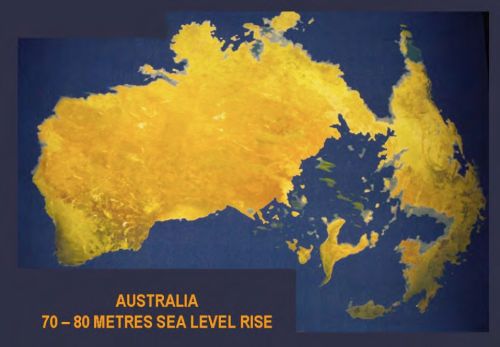
As the century unfolds we will see more images like this is near Winda Woppa in NSW:
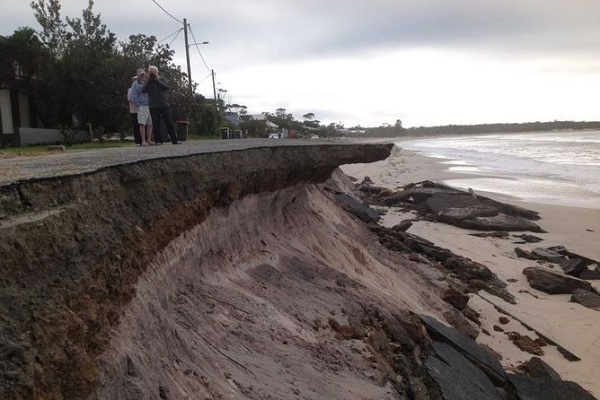
And this one showing Surfers Paradise after a storm:
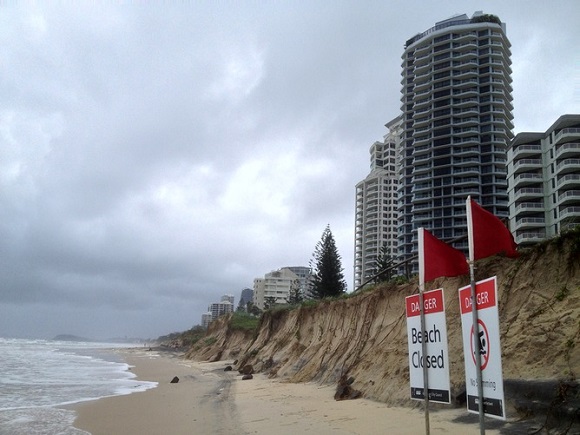
Those images come from my 2015 post Scoping long-term sea level change, which, I think does not yet warrant revision.
Complete deglaciation with 75 metres SLR will likely flow from 500 (400-600) ppm and a temperature variance of 5 to 7°C.
David Archer’s 2006 graph makes common sense:
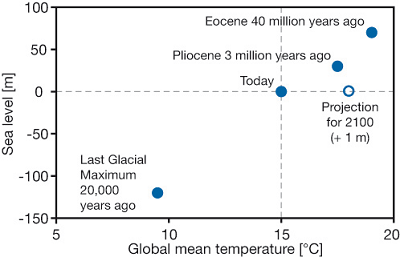
You don’t need to be a genius to work it out. From 22,000 years ago 5°C or so gave of 120 metres of SLR. The Holocene has been set in a Goldilocks spot, where the NH continental and Patagonian ice sheets have gone, and Greenland and Antarctica have been stable. That is no longer the case and a further 5°C or so will see a further 75 metres or so. How that happens and over what time frame is impossible to work out, because we are forcing the system many times harder than the Melankovitch cycles, the planetary orbital changes which are associated with the oscillations between ice ages and interglacials, essentially since the closure of the Panama Isthmus over 3 million years ago. Also we are emitting CO2 somewhere between 20 and 120 times as fast as happened during Paleocene–Eocene Thermal Maximum (PETM) 55m years ago. During that episode global temperatures increased by 5-8°C and drove widespread extinction of species on both the oceans and land. Esentially what is happening now is without precedent.
A year ago we found that Antarctic ice loss rates have tripled since 2012
Hansen thinks that sea level rise will proceed in an accelerating pattern roughly along these lines:
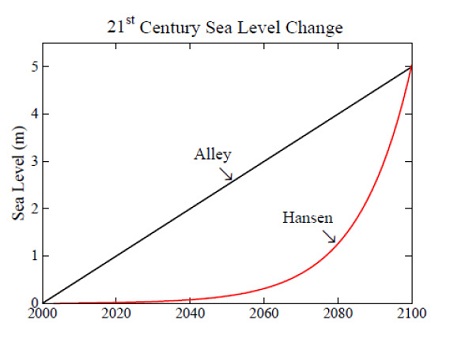
That was based on a doubling every 10 years. Hansen did not say this would happen, rather that it could. We need another 10 years data to see a pattern emerge. Since then he has pegged back expectations a little. However, things could get wild in the second half of the century.
Spratt and Dunlop in What lies beneath say:
- One of most significant research findings in 2014 was that the “tipping point’ has already passed for one of these “long-term” events. Scientists found that “the retreat of ice in the Amundsen Sea sector of West Antarctica was unstoppable…”
Just now we have been told that Antarctica’s Ice Is Melting 5 Times Faster Than in the 90s, and a new study based on averaging expert opinion suggests planners use 2 metres SLR or more as an upper limit expectation for this century.
Watch this space.
If you want to check out your own place, or anywhere in the world, you can do so at Firetree flood maps. Cairns, the Gold Coast, Brisbane Airport in play with a couple of metres SLR. Four to five metres becomes simply catastrophic. I checked out Ashgrove in Brisbane, where I live. If current CO2 levels commit us to longer term SLR of 20 metres, this is a screenshot of what we’ll get:
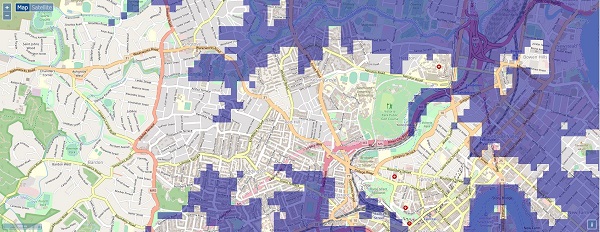
Our place backs onto that lovely green patch on the far LHS. However, at the other end of the suburb, top middle, the water cuts Waterworks Road near Red Hill. The water laps our place at 50 metres, by which time more than 90 par cent of Brisbane is under.
Of course, SLR is not just a matter of water rising like a bath tub. It is the storm surges and floods that get you first, if it’s not penetration of saltwater into underground aquifers and fertile deltas.
China’s exposure in the Pearl River Delta, where over 30 million live and manufacture stuff for the world within a metre of sea level, plus squishiness around Shanghai and the northern food-producing plains, may be the impetus for action that will save us all.
6. Temperature
According to Hansen et al in 2018 global temperature was + 1.1°C (~2°F) warmer than in the 1880-1920 base period; we take that base period as an estimate of ‘pre-industrial’ temperature. Here’s the graph:
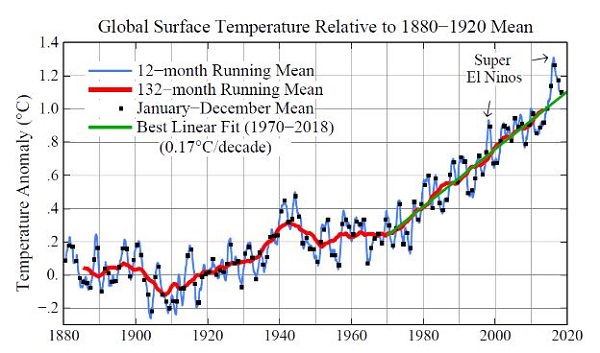
I like their use of the 132-month running mean and a trend line, though not where they are heading.
We have now been told that the mean global temperature for January-May 2019 was 1.25°C above the 1880-1920 baseline NASA uses for ‘pre-industrial’ temperatures. Furthermore, if we turn off all the fossil fuel-based emissions now, temperatures will rise by about 0.5°C.
How can we kid ourselves that containing the temperature rise 1.5°C is at all possible?
Hansen et al also tell us that the 2016 global temperature record was abetted by its near coincidence with a solar maximum, which does indeed make a difference. However, we now appear to be reaching those levels with solar activity in a quieter phase. Time will tell.
7. What should we do?
Clearly we need to reach zero net emissions as soon as possible. Hansen, after being asked by Bill McKibbin where we should head in 2007 thought for a few months, and gave his answer to a special meeting at the December 2007 American Geophysical Union conference as newly-minted environment minister Penny Wong was in Bali at the annual UNFCCC Conference of Parties that eventually gave us the Paris Agreement in 2015. Bill McKibbin had an idea to start a 450.org organisation to encourage climate action.
Hansen said, no, we have already gone too far, the climate is already dangerous. Two degrees is already a “prescription for disaster”. For a safe climate we need to take CO2 out of the air to reach 350 ppm, that is CO2, ASAP under the assumption that the other six ‘Kyoto’ greenhouse gases (methane, nitrous oxide etc) were neutralised. That is for a safe climate. When we get to 350, he said, science will have advanced and we will know if that is adequate or where next. We need to turn down the dial on global warming.
See NASA’S James Hansen says Atmospheric CO2 is Already Beyond Safe Limit.
That was at 383 ppm. Try 414.83 for May 2019.
Part of his reason for not going lower than 350 was that the earth’s surface is now more reflective than it was pre-industrially, thus reflecting more heat.
Thus 350.org was born.
In 2007 also David Spratt and Philip Sutton wrote an online piece The Big Melt after Arctic sea ice coverage had crashed unexpectedly. Ahead of Hansen, they recommended we head for 320 ppm for a safe climate. The work was enlarged and published as Climate Code Red in mid 2008. A blog of the same name was founded, which has been I think the leading blog in the world which foregrounds the science supporting a climate emergency and the primacy of aiming for a safe climate.
8. What have we done?
Well, nothing that makes much difference. Here is the graph of CO2 emissions from the Australian BOM State of the Climate 2018 (pdf here) at Cape Grim:
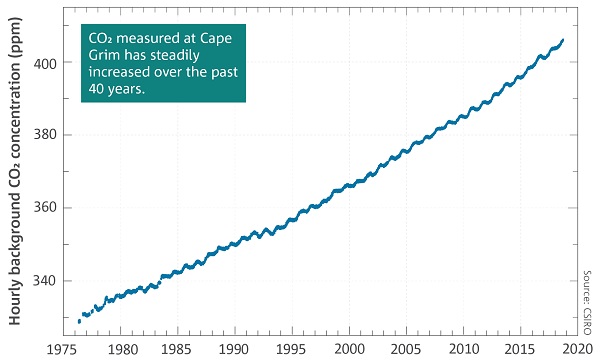
Checking the Mauna Loa site, May 2019 was 414.83, that is 3.53 higher than May 2018.
9. Some future pointers
In a post Climate change: the end of civilisation as we know it there was a link to this NASA site which says that current levels of CO2 were last reached in the Pliocene, 3-5 million years ago:
- Imagine there are no people. Imagine a planet where the sea level is about five to 40 meters (16 to 131 feet) higher than normal. Imagine a planet that is hotter and wetter. Imagine, worldwide, it’s roughly 3 to 4 degrees Celsius (5.4 to 7.2 degrees Fahrenheit) warmer than today. And the North and South poles are even warmer still – as much as 10 degrees Celsius (18 degrees Fahrenheit) hotter than today.
Welcome to the Pliocene.
Five to 40 meters is a large uncertainty band, but the lower bound is completely catastrophic.
That is the legacy we are leaving for the future if we reach zero net emissions right now.
Remembering that land temperature warming is approximately double sea surface warming, and low latitude change will be perhaps three to five times greater than at the equator, this is one forecast of a world four degrees hotter than pre-industrial:
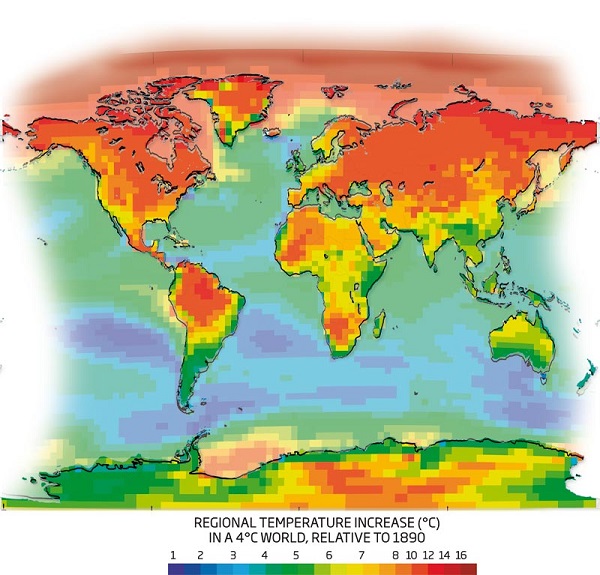
Please note that green is not a pleasant colour in this case.
Here’s what Hansen thinks might be the case in 2060:
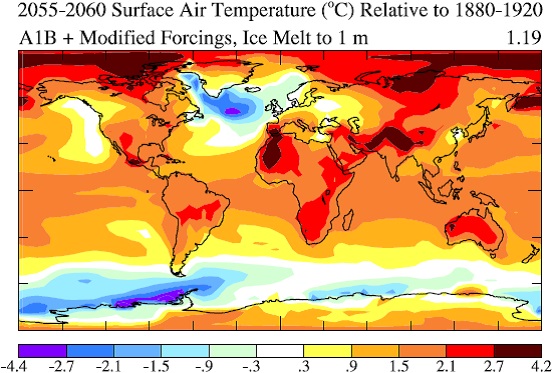
In that instance he was pondering the ocean cooling effect of rapidly melting ice. That illustrates why, whatever is forecast, something different will probably happen.
10. What next?
I could go on about extreme weather events, wildfires, the developing extinction crisis, the effects on health, farming, food production and more. A global movement for recognising a climate emergency is in train.
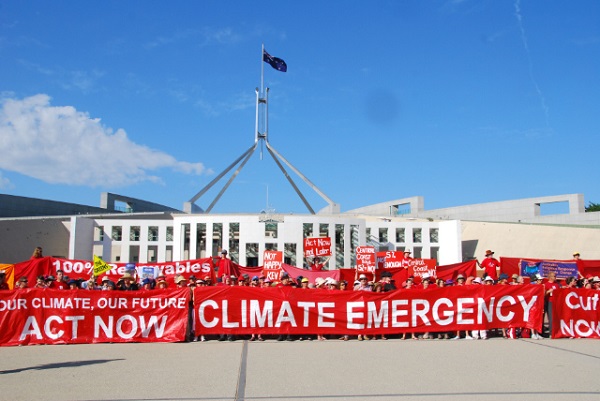
(BTW I think that’s from 2009. They wouldn’t let people get so close now.)
Sydney City is the latest to declare a climate emergency (see image at the head of the post).
We need to turn down the climate dial to 350 ppm as fast as possible. The Coalition Coalsheviks will never be persuaded, so they need to be defeated.
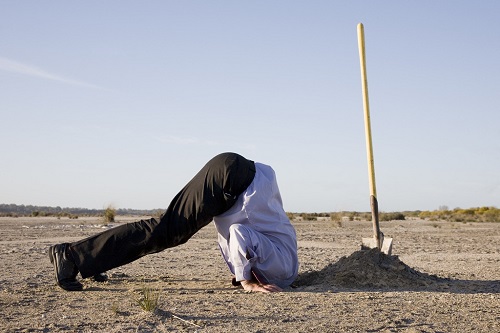
The only way to do this, I think, is to face the issue squarely.
When the issue looks impossible, we need to take the first step, but leadership needs to come from government at every level. Individual effort is worthy, welcome and necessary, but will not be sufficient, and individuals cannot be blamed for feeling discouraged and overwhelmed as recent research on the great Barrier Reef shows.
My next post will be a short (promise!) one on how we should start.

Dave Gilmour has made a move.
That’s good, zoot. Every bit helps, and people who have a ‘pulpit’ as it were, can make a difference.
Brian: “Eat drink and be merry for tomorrow we die” may be the only rational response to this very pessimistic (or realistic?) post. In the meantime I am thinking through the Davidson Darwinian plan (which will be all about maximizing the probability of the Davidson genes surviving.)
On a more optimistic note someone said BHP was like an elephant: Hard to get moving but very hard to stop once it gets going. Hopefully, collective humanity will be the same.
John, I’m planning a post about things we can do. It’s not altogether hopeless. I think I’ll promote that one in the order of business.
Now up Climate emergency – the next (political) step, which I’m hoping someone in the Labor Party might read.
Here in the Southern Netherlands I see everywhere. Very few are ever stopped for any length of time. This Summer near Rotterdam they installing a record 12 megawatt wind mill. There is a guy in the warehouse who parrots the usual denialist talking points, though he is slowly running out of steam. “Wind mills kill birds” he was saying till recently when I reported that on a trip to Middleburg we didn’t see a single dead bird under a windmill, but we did see quite a few along the road, should we ban cars? The myth of windmill bird kills goes back to the early machines with small diameter high rotational speed blades. They did kill birds back in the eighties. Today’s very high energy wind mills turn very slowly and birds can avoid the blades.
What do these windmills do? One of the things they do in a land with significant sections below sea level is pump water (electrically and remotely of course). Another thing they do is charge electric cars. Then there are all of the other electricity users who are served. The water pumping is a load for which timing is highly flexible, so there is here a very well managed use of wind power.
Keep in mind that water pumping is a new growing need for many cities in the near future, both for reacting to sea level rise and for water desalination.
Australia has taken the biggest step towards a better future by disposing of Abbott wholey and completely, and while there may still be a climate action deadlock with Morrison, that may not last very long.
….windmills everywhere…… that is.
Bilb:
We need to spend more time thinking about what power demands can be managed to fit in with variable renewable energy instead of just installing energy storage to fit in with variable generation and demands that need to be satisfied at particular times.